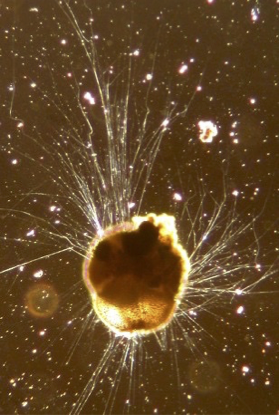Climate
Contents
Climate#
IN THE SPACE BELOW, WRITE OUT IN FULL AND THEN SIGN THE HONOR PLEDGE:
“I pledge my honor that I have not violated the honor code during this examination.”
PRINT NAME:
If a fellow student has contributed significantly to this work, please acknowledge them here:
Peer(s):
Contribution:
By uploading this assignment through Canvas, I sign off on the document below electronically.
Part I: Natural and Anthropogenic Variability#
Objectives
Describe the pattern of ocean 18O variations over the past 2 million years, using data from benthic foraminifera.
Use this data to infer the pattern of ice-volume changes and identify glacial and inter-glacial periods.
Compare the benthic foraminifera results to CO2 record of ancient atmosphere trapped in bubbles in the Antarctica ice cores.
Mini-tutorial#
Oxygen isotopes and Climate
The concentration of 18O in water and sediment is represented as \(\delta\)18O values with units of per mil (parts per thousand, or ‰). Average ocean water is assigned a value of 0‰, and is the standard against which variations in 18O/16O are measured and reported. The process of fractionation, the preferential removal of one isotope over another during a phase change, results from the mass difference of water molecules containing 18O (a.k.a., “heavy water”) and of water molecules containing 16O (“light water”) in the Earth climate system.

Question 1.1 Will ocean water be isotopically light or heavy during a glacial period, compared to during an interglacial period? Explain why. Hint: Think about ease of evaporation.
Answer:
\(\delta\)18O data and climate change from benthic forams#
A series of programs funded by the U.S. National Science Foundation and 22 international partners has used the scientific drill ship JOIDES Resolution (Joint Oceanographic Institute for Deep Earth Sampling) to drill into the ocean floor, both into unconsolidated sediment and into the ocean crust below the sediment:
1968-1984: Deep Sea Drilling Project (DSDP)
1985-2003: Ocean Drilling Project (ODP)
2004-2012: Integrated Ocean Drilling Program (IODP)
2013 and ongoing: International Ocean Discovery Program (IODP).
Question 1.2 Describe the IODP expedition the Resolution is currently involved in and tell where the ship is right now! See current expedition information at https://iodp.tamu.edu/scienceops/sitesumm.html
Answer:
Benthic forams
Here, you will analyze \(\delta\)18O data measured in foraminifera. “Forams” are shelled microorganisms found in aquatic environments. There are both planktonic (floating in the water column) and benthic (bottom dwelling) varieties. Foram shells are made up of calcium carbonate (CaCO3) and when the organisms die, their shells get buried and preserved in sediment. The chemical make-up of the shells reflects the water chemistry at the time of shell formation. For this problem set, we focus on the benthic forams which better reflect bulk ocean chemistry as opposed to planktonic forams which better reflect surface water temperature.

Figure: Live Ammonia tepida benthic foraminiferan collected from San Francisco Bay. Phase-contrast photomicrograph by Scott Fay, UC Berkeley, 2005.

Figure: Scanning electron microscope photographs of 16-28 My foram shells recovered from an Indian Ocean sediment core. Scale bars are 0.1 mm. Source: Ridha et al., 2019
Shown below is a plot of \(\delta\)18O (on the y-axis) as a function of age (on the x-axis) for the past several million years. Modern times are to the right, and age increases to the left.
Global benthic stack for the last 5.5 Ma accessed from ncei.noaa.gov based on the following study Lisiecki, L.E. and M.E. Raymo. 2005. A Pliocene-Pleistocene stack of 57 globally distributed benthic D18O records. Paleoceanography, 20, PA1003. doi: 10.1029/2004PA001071
import pandas as pd
benthic2005d18O = pd.read_excel('Files/lisiecki2005.xls', sheet_name='benthic_d18O')
benthic2005d18O
| Time_(ka) | Benthic_d18O_(per_mil) | Standard_error_(per_mil) | |
|---|---|---|---|
| 0 | 0 | 3.23 | 0.03 |
| 1 | 1 | 3.23 | 0.04 |
| 2 | 2 | 3.18 | 0.03 |
| 3 | 3 | 3.29 | 0.03 |
| 4 | 4 | 3.30 | 0.03 |
| ... | ... | ... | ... |
| 1810 | 5300 | 2.91 | 0.06 |
| 1811 | 5305 | 2.79 | 0.04 |
| 1812 | 5310 | 2.79 | 0.09 |
| 1813 | 5315 | 2.84 | 0.07 |
| 1814 | 5320 | 2.91 | 0.09 |
1815 rows × 3 columns
import plotly.graph_objects as go
fig = go.Figure(data=go.Scatter(x=benthic2005d18O['Time_(ka)']*1000, y=benthic2005d18O['Benthic_d18O_(per_mil)'], mode='lines+markers'))
# Create axis objects
fig.update_layout(
xaxis=dict(
domain=[0., 1.],
title="Years before present",
titlefont=dict(
color="#000000"
),
tickfont=dict(
color="#000000"
)
),
yaxis=dict(
title="Benthic d18O (per mil ‰)",
titlefont=dict(
color="#1f77b4"
),
tickfont=dict(
color="#1f77b4"
),
anchor="x",
overlaying="y",
side="left",
position=0.15
)
)
fig['layout']['xaxis']['autorange'] = "reversed"
fig.show()
Question 1.3 Exploring the long-term trends.
(A) What is the range through which \(\delta\)18O values fluctuate between 5.5 million and 1 million years ago?
(B) Between 500,000 yr and the present?
(B) What could this indicate about the difference in global ice volume during these two intervals?
Answer:
Question 1.4 Zoom into the past 500,000 years to focus in on that time interval. Within the \(\delta\)18O record, you can identify intervals of isotope change or “excursions.” Intervals of greatest ice volume are termed glaciations, whereas intervals of least ice volume are termed interglacials. Attach an annotate figure of your 500,000 year graph that indicates:
the five times that indicate the greatest ice volume (peak glaciation)
the times that indicate the interglacial periods.
Answer:
Question 1.5 Describe the cyclicity of the \(\delta\)18O signal on the 500,000 graph. For example, what is the duration of each cycle (from peak of glaciation to the next)? What is the average duration?
Answer:
Question 1.6 Consider the rate of change in \(\delta\)18O values. Which is faster, the building up of global ice volume (more snow falling in the winter than melts in the summer) or the waning of global ice volume (less snow falling in the winter than melts in the summer).
Answer:
Question 1.7 How long ago was the peak of the most recent glaciation? Do you think we are overdue for the onset of the next ice age? Explain why or why not?
Answer:
CO2 data and climate change from Ice Cores#
Ice Cores drilled in the Antarctic give us a peek into the climate of the past several thousands of years. Antarctic CO2 data core records both the precipitation (snow transformed into glacial ice) and ancient atmosphere (trapped air bubbles) in Antarctica. Samples from the entire length of the core have been analyzed for dust, methane, CO2, and deuterium (“heavy hydrogen”). We focus on the CO2 content of trapped bubbles of ancient atmosphere from a composite study of all ice cores that goes back 800,000 years, accessed from ncei.noaa.gov based on the following study: Bereiter, B., S. Eggleston, J. Schmitt, C. Nehrbass-Ahles, T. F. Stocker, H. Fischer, S. Kipfstuhl, J. Chappellaz. 2015. Revision of the EPICA Dome C CO2 record from 800 to 600 kyr before present. Geophysical Research Letters, 42(2), 542-549. doi: 10.1002/2014GL061957

Figure: A slice of ice core, showing trapped air bubbles. Photograph: British Antarctic Survey/PA
import pandas as pd
antarctica2015co2 = pd.read_excel('Files/antarctica2015co2.xls', sheet_name='CO2 Composite', header=14)
antarctica2015co2
| Gasage (yr BP) | CO2 (ppmv) | sigma mean CO2 (ppmv) | |
|---|---|---|---|
| 0 | -51.030000 | 368.022488 | 0.060442 |
| 1 | -48.000000 | 361.780737 | 0.370000 |
| 2 | -46.279272 | 359.647793 | 0.098000 |
| 3 | -44.405642 | 357.106740 | 0.159923 |
| 4 | -43.080000 | 353.946685 | 0.043007 |
| ... | ... | ... | ... |
| 1896 | 803925.284376 | 202.921723 | 2.064488 |
| 1897 | 804009.870607 | 207.498645 | 0.915083 |
| 1898 | 804522.674630 | 204.861938 | 1.642851 |
| 1899 | 805132.442334 | 202.226839 | 0.689587 |
| 1900 | 805668.868405 | 207.285440 | 2.202808 |
1901 rows × 3 columns
import plotly.graph_objects as go
fig = go.Figure(data=go.Scatter(x=antarctica2015co2['Gasage (yr BP)'], y=antarctica2015co2['CO2 (ppmv)'], mode='lines+markers'))
# Create axis objects
fig.update_layout(
xaxis=dict(
domain=[0., 1.],
title="Years before present",
titlefont=dict(
color="#000000"
),
tickfont=dict(
color="#000000"
)
),
yaxis=dict(
title="CO2 (ppmv)",
titlefont=dict(
color="#1f77b4"
),
tickfont=dict(
color="#1f77b4"
),
anchor="x",
overlaying="y",
side="left",
position=0.15
)
)
fig['layout']['xaxis']['autorange'] = "reversed"
fig.show()
Question 1.8 How would you expect the CO2 content of the atmosphere during a glacial period to compare to the CO2 content of the atmosphere during an interglacial period? Explain your reasoning in a few sentences.
Answer:
Comparison of climate records from Antarctica versus benthic forams globally#
Question 1.9 Compare the CO2 data from the Antarctic ice cores, with the \(\delta\)18O data from benthic forams. Do they tell a consistent picture of global climate over the last 800,000 years? Explain in a brief, well-written paragraph or two, referring appropriately to the data sets and graphs.
fig = go.Figure()
fig.add_trace(go.Scatter(x=benthic2005d18O['Time_(ka)']*1000, y=benthic2005d18O['Benthic_d18O_(per_mil)'],
mode='lines+markers',
name='d18O'))
fig.add_trace(go.Scatter(x=antarctica2015co2['Gasage (yr BP)'], y=antarctica2015co2['CO2 (ppmv)'],
mode='lines+markers',
name='CO2',yaxis="y2"))
# Create axis objects
fig.update_layout(
xaxis=dict(
domain=[0., 1.],
title="Years before present",
titlefont=dict(
color="#000000"
),
tickfont=dict(
color="#000000"
)
),
yaxis=dict(
title="Benthic d18O (per mil ‰)",
titlefont=dict(
color="#1f77b4"
),
tickfont=dict(
color="#1f77b4"
)
),
yaxis2=dict(
title="CO2 (ppmv)",
titlefont=dict(
color="#ff7f0e"
),
tickfont=dict(
color="#ff7f0e"
),
anchor="x",
overlaying="y",
side="right",
position=0.15
)
)
fig['layout']['xaxis']['autorange'] = "reversed"
fig.show()
Answer:
Question 1.10 Modern Measurements: What is the CO2 content of Earth’s atmosphere today. Provide the latest values from Mauna Loa in Hawaii available from https://gml.noaa.gov/ccgg/trends/data.html
Answer:
Question 1.11 Revisit your response regarding potential ice age based on the curve above in Question 4.7. Do you think we are due for the onset of the next ice age? Explain why or why not.
Answer:

